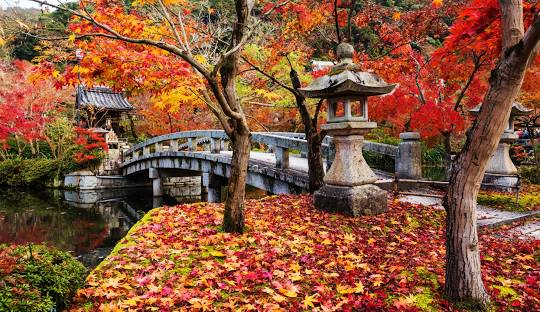Eikando Temple, one of Kyoto’s most renowned spots for autumn colors, captivates visitors with its stunning fall foliage and enchanting evening illuminations. This comprehensive guide will unveil the charms of Eikando and help you plan an unforgettable visit.
Eikando at a Glance
- Official name: Zenrinji Temple
- Buddhist sect: Jodo (Pure Land)
- Main features: Autumn colors, evening illuminations, unique Amida Buddha statue
- Location: North of Nanzenji Temple
- Best time to visit: Mid to late November
Rich History
Eikando’s history dates back to the Heian Period (794-1185). Originally a noble’s villa, it was converted into a temple named Zenrinji. Initially belonging to the Shingon sect, its first head priest was a disciple of Kobo Daishi, the sect’s founder.
In the 11th century, a popular head priest named Eikan gave the temple its common name, “Eikando.” Legend has it that the temple’s main object of worship, an Amida Buddha statue with its head turned sideways, once spoke to Eikan during his walk through the temple.
In the 13th century, a later head priest converted the temple to the Jodo sect, impressed by its founder Honen, whose mausoleum is at nearby Chionin Temple.
Main Attractions
Main Hall Complex
Eikando’s main buildings, connected by wooden corridors, line the base of the hillside. Visitors first enter the Shakado (Hall of the Historical Buddha), featuring a small rock garden and beautifully painted sliding doors. The tour continues through the Miedo, enshrining the Jodo sect’s founder Honen, and the Amidado (Amida Hall), housing the unique sideward-facing Amida statue.
Tahoto Pagoda
Eikando’s most recognizable structure is the Tahoto Pagoda, nestled in the hillside trees. This two-story pagoda, square on the first floor and round on the second, offers panoramic views of the temple grounds and Kyoto city, especially breathtaking during autumn.
Hojo Garden
The Hojo Garden, centered around a pond, is another prime spot for autumn colors. Small streams crisscross the temple grounds, connecting to the main pond with its small island shrine. The fall colors typically peak in the second half of November, coinciding with special evening illuminations.
Best Time to Visit
While Eikando is open year-round, autumn is undoubtedly the most spectacular season. Mid to late November offers the best fall colors, complemented by special evening illuminations that showcase the foliage in a magical light.
Access Guide
- Subway: 15-20 minute walk from Keage Station on the Tozai Line (20 minutes, 260 yen from Kyoto Station)
- Bus: 5 minute walk from Nanzenji-Eikando-michi bus stop (35 minutes, 230 yen from Kyoto Station on Kyoto City Bus number 5)
- On foot: Near the southern end of the Philosopher’s Path, 5 minute walk from Nanzenji Temple
Hours and Admission
- Regular hours: 9:00 to 17:00 (last entry at 16:00)
- Autumn illuminations: Early November to early December, 17:30 to 21:00 (last entry at 20:30)
- Admission fees:
- Regular: 600 yen
- Autumn season: 1000 yen daytime, 600 yen for evening illuminations
Visitor Tips
- Plan ahead, especially during peak autumn season
- Wear comfortable walking shoes
- Bring a camera to capture the stunning scenery
- Respect temple etiquette and maintain a quiet atmosphere
- Consider attending the evening illuminations for a different perspective
Official Website
Conclusion
Eikando Temple, with its breathtaking autumn scenery and rich cultural heritage, is a must-visit destination in Kyoto. Whether you’re a photography enthusiast, history buff, or simply seeking beautiful views, Eikando promises an unforgettable experience. Make sure to include this thousand-year-old temple in your Kyoto itinerary and immerse yourself in its unique charm!
